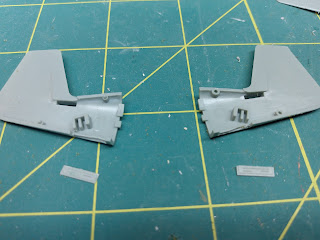First step was to make the main gear doors fit, which took some shaving down of the raised detail on the inner surface of the doors, and to cut away the tailwheel doors and widen the tailwheel opening to allow them to fit.
I didn't quite get the doors perfectly flush, so a bit of filler was required.

Oops, sorry, no photos of the cockpit or the figure of then-Captain Anderson, which
I swiped from an Airfix P-51 (the new tool kit, so the figure's not bad). Here you see the primered model with Vallejo masking fluid over the canopy. I like the Vallejo product much better than Microscale Micro Mask, which beads up on smooth surfaces. The Vallejo mask stays where I put it.
I got out my trusty Paasche Model H and preshaded the whole airframe with Mr. Color flat black. That single action airbrush is excellent for all but the finest lines, and it has only three parts to clean. Cleaning the Paasche H is even quicker and easier than cleaning a paintbrush, but you can get a beautiful paint job you'd never achieve with a paintbrush. Those are the two things I look for in a tool: better results and/or less trouble.
The important thing to remember about preshading is to airbrush very light coats over it and stop before you totally obscure it! I had a stock of Hataka paint I'd bought for various projects, and decided to use their Olive Drab (Late) and Neutral Gray. 

I'll have to take some more pictures of the finished model and post them later.
















